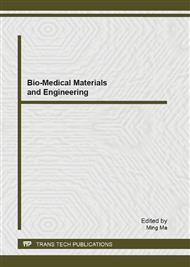p.192
p.198
p.206
p.211
p.215
p.221
p.228
p.232
p.236
Effects of Free Radical Mediator NF-κB Expression Change on Brain in Aging Mice after Various Load Aerobic Training
Abstract:
ntroduction: This study was to explore the mechanism of exercise induced anti-aging effects on brain at molecular level in mice, which may provide some fundamental evidences for further research in anti-aging in human beings. Methods: 60 male mice (3 month old) were randomly divided into 4 groups: control group (group C), exercise group 1-3 (group E1, E2, and E3) with 15 in each group. Group E1 to E3 had swimming exercise at various load (30, 60, and 90min/day for E1, E2 and E3 respectively) for 8 monthes. The subjects were decapitated immediately and gained brain after the last exercise. The amount of SOD and MDA in gastrocnimius were measured by colorimetric method. The expression of NF-κB P50 mRNA and its protein amount were measured by Western-Blot and RT-PCR. Results and Conclusions: 1) NF-κB was sensitive to exercise stimulation and its actitity level was affected by exercise load. 2) The brain improved their anti-oxidization ability due to the adaptable changes of the antioxidant enzymes after long time moderate load aerobic exercise, which sped up the free radical clearance in the brain to reduce its impairment and meanwhile inhibited the activity of NF-κB. This process could be one of the anti-aging machanisms through aerobic exercises. 3) In long time over-load exercise (90 minutes), the free radicals in the brain accumulated and could not be cleared up timely, which would decrease the anti-oxidization ability. This process would activate NF-κB and enhance its expression, which may result in inflammation reactions and cellular dying, therefore speeding the aging process.
Info:
Periodical:
Pages:
215-220
Citation:
Online since:
August 2013
Authors:
Keywords:
Price:
Сopyright:
© 2013 Trans Tech Publications Ltd. All Rights Reserved
Share:
Citation:


